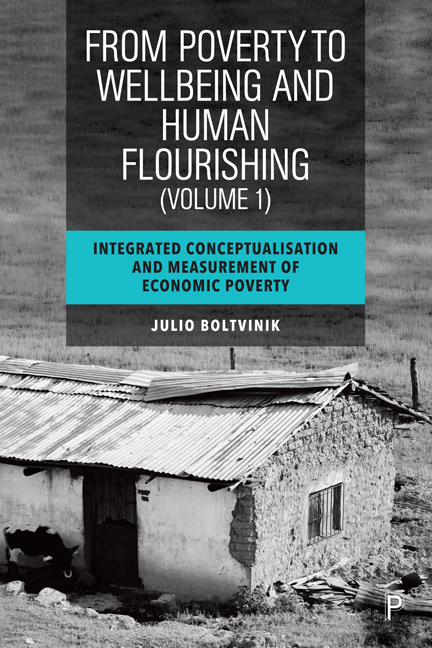 From Poverty to Well-Being and Human Flourishing
From Poverty to Well-Being and Human Flourishing 6 - A typology of poverty measurement methods: a critique of direct and indirect poverty measurement methods
Published online by Cambridge University Press: 28 March 2024
Summary
6.1 A systematic typology: comparison with Gordon et al.’s and Ringen’s views of poverty measurement methods
The typology I present here classifies PMM, in the first place, into normative (No), semi-normative (SN) or non-normative (NN) methods. I consider normative those PMM that define the threshold(s) separating the poor from the non-poor based on a notion of the acceptable minimum level of life or on a conception of the N that must be satisfied, and the S required to meet them. No and SN methods are additionally classified on the basis of two characteristics: the direct or indirect nature of the measurement of WB (or deprivation) and the use of one or various indicators in one or various dimensions. This gives rise to the further classification of methods into the categories of direct and indirect, and one-dimensional and multidimensional. The methods that use both direct and indirect indicators I call combined.
In the following pages I compare this typology with Ringen’s (1995), as well as with the methods described by Gordon et al. (2000). I include a critique of direct and indirect methods, leaving the critique of combined methods for Chapter 7.
I have not included Sen’s CA in the typology, since it has not been made operational to measure P or the standard of living. Neither have I included the measurement of social exclusion, for this concept is different from that of P, regardless of the serious difficulties encountered for its definition and measurement.
Table 6.1 presents a synthetic typology of PPM. The typology is built on three axes: the first axis (displayed in the columns) is the one-dimensional or multidimensional character of each method; the second (displayed in the rows), the indirect, direct or combined nature of each method; and the third (also shown in the rows), the No, SN or NN character of the methods (the first two categories have been grouped together in the table). All the NN methods included are indirect. With these simplifications, a matrix with potentially 18 cells was reduced to an eight-cell matrix where three cells remain empty.
- Type
- Chapter
- Information
- From Poverty to Well-Being and Human FlourishingIntegrated Conceptualisation and Measurement of Economic Poverty, pp. 109 - 128Publisher: Bristol University PressPrint publication year: 2023


